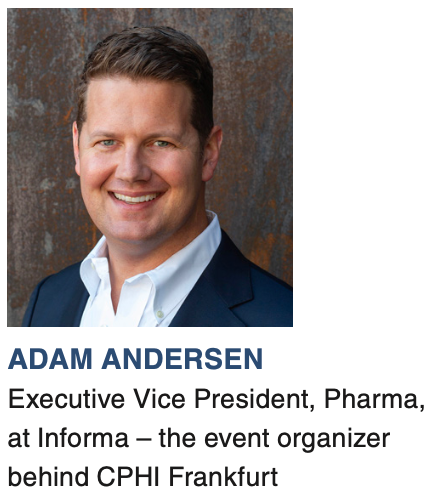At the Heart of Pharma: ESG has Arrived as a Central Strategy
Pharma supply chains are no longer hidden beyond the reach of ESG agendas, making it important for companies to accelerate adoption of new manufacturing processes and environmental technology.

One of the most significant transformational changes to hit the pharmaceutical industry in the last three years—and not just the result of the pandemic—has been the rapid acceleration and focus on sustainability initiatives. This is due to the wider environmental, social, and governance (ESG) agenda that has become an essential part in the strategic development of every corporation, including those in the pharma world.
The first big steps in the pharma supply chain sustainability journey were taken about seven years ago by pharmaceutical packaging companies, which have continued to lead the charge and have remained at the forefront of sustainability initiatives.
Since then, we have seen all parts of the contract development and manufacturing organization (CDMO) industry mirror trends in wider society with a huge shift in adoption toward new manufacturing processes and environmental technology. From green chemistries and metal catalysis to continuous processing, the industry has increasingly voiced its desire to improve the environmental impact of its manufacturing and processes, bringing about a paradigm shift in how innovators develop medicines quickly and sustainably.
For an industry that’s historically been driven by the twin imperatives of cost and speed of development, the impact of sustainability continues to create positive ripples across the industry, with profound implications for infrastructure planning as well as for how contract service providers market their services to innovators. The consensus among CPHI Annual Report experts is that investments need to be made now in modern manufacturing to prepare for these shifts.
The CPHI sustainability sentiment index points to an almost universal consensus among biopharma executives and leaders that environmental credentials are now integral to all supply chain decisions. In a global survey we will release in full ahead of CPHI Frankfurt (Nov. 2–4), 95% of industry executives—including representatives from pharma, biotech, and CDMOs—suggest it is either “important” or “extremely important” to have visibility on supply chain partners’ sustainability credentials and practices.
Underlying their concerns with sustainability, 83% of surveyed pharma industry executives believe that within the next five years, specific “sustainability metrics” (e.g., full waste recycling, green power percentage, low process mass intensity [PMI], and green chemistries) will be implemented within all CDMO contracts—suggesting the industry must accelerate its drive toward modern manufacturing and more efficient chemistries. In fact, nearly 60% believe CDMOs will be required to provide their partners with both sustainability metrics for projects and specific corporate ESG goals.
Given this momentum, it’s not a surprise that this year’s CPHI Frankfurt show will dedicate an entire theater to sustainability, gathering more than 20 industry experts across 15 targeted sessions, covering everything from ingredients and excipients, ESG risks and requirements, to the impact on quality, metrics, supply chains, and biologics. A particular highlight will be Boehringer Ingelheim and Novartis presenting on the new iGAL 2.0 metric (a new metric to measure sustainability in manufacturing against industry averages) and how this can be successfully integrated into pharma-CDMO partnerships.
Talking ahead of his session in November, Aurelio Arias from IQVIA forewarns that healthcare services are now looking to use their considerable buying power to impact change, “having identified medicines as one of the largest single contributors to their carbon footprint.”
Another significant driver of change is from the investor side, with much of the impetus toward sustainability coming from financial institutions. In fact, ESG funds now account for about one-quarter of US stock and bond mutual funds, and the percentage is growing.1
This reach even extends to the M&A environment, with investors looking not only for tomorrow’s most potentially valuable biotechs and supply-side companies, but also for those with the most ambitious and developed ESG goals. If we take a medium-term picture of the pharma industry, this will have tremendous influence over decisions in the next five years.
The investment community is telling us loud and clear at CPHI events that they actively evaluate a company’s ESG track record as part of planning their future investments. At CPHI North America, a session with venture capital (VC) firms discussed the recent transition to an ESG-driven market. VCs emphasized the value ESG structures bring to biotechs in the early stages of development—with ESG-compliant companies likely to deliver better valuations on sale, and greater licensing options. Having this structure in place early, particularly in the supply chain, means the purchasing pharma company or investor knows it’s a good fit with their existing sustainability goals, an important consideration because retrofitting a sustainable business mode is potentially a risky and costly operation. So much so, it’s a future deal-breaker.
Consequentially, CDMOs are also feeling the pressure to improve their ESG reporting. In the past, CDMOs were a largely hidden aspect of the industry, often protected by confidentially agreements with sponsors. But they now face pressure not just from customers, but also from potential private equity partners, to bring their ESG activities and their reporting of them into line with industry best practice.
Compared to just a few years ago, awareness of something as seemingly technical as PMI—the measure of waste in any given pharmaceutical process—is now at an all-time high, as the industry constantly pushes for better working practices. In an annual survey, a remarkable 87% of respondents predict “innovators (pharma and biotech) will require CDMOs to implement sustainability goals as part of all new contracts within the next five years.”2
Perhaps the starkest warning from experts is that companies which have not yet embedded ESG into how they do business are already behind, and rate of change is accelerating. The impact of failing to embrace ESG will only grow in the next few years—with particular impacts on their supply chain contracts and clients, with even regulatory forbearance now nearing reality as well. In the next two years, European regulations will cover both supply chain transparency and the environmental impacts of this supply chain—for active pharmaceutical ingredient (API) and finished-dosage companies.3 This will be for generic and innovator medicines alike. The good news, particularly for those at the front of the wave of ESG integration, is that these regulations will level the playing field with standardized reporting structures.
So what does this mean for pharma executives? It means they must have clear visibility now on the total life-cycle impact of their respective company’s manufacturing. That includes the need for its manufacturing and particularly the environmental impact to be documented thoroughly, and done so with an eye on a future where oversight and reporting expectations will only grow. Any pharma company not asking the right questions of suppliers risks facing challenges in the near future from regulators, consumers, investors, and governments.
It’s not enough to report a company’s own ESG performance and goals; the organization must be confident it can understand and illustrate the supply chain impact of its partners’ work, and look for those that share a commitment to open reporting.
Adam Andersen, Executive Vice President, Pharma, at Informa – the event organizer behind CPHI Frankfurt
References
- https://www.bloomberg.com/professional/blog/esg-assets-may-hit-53-trillion-by-2025-a-third-of-global-aum/
- CPHI Annual Report 2022 (released in full at CPHI Frankfurt)
- https://ec.europa.eu/commission/presscorner/detail/en/ip_22_1145, CPHI Annual Report 2022

Pharma's ESG Equation: Materiality and Strategy are Key
August 11th 2023Life sciences executives who are confronted by too many choices in launching their environmental, social, and governance programs can leverage these two foundational tools to hone in on the set of issues, actions, and disclosures they should prioritize to create value.